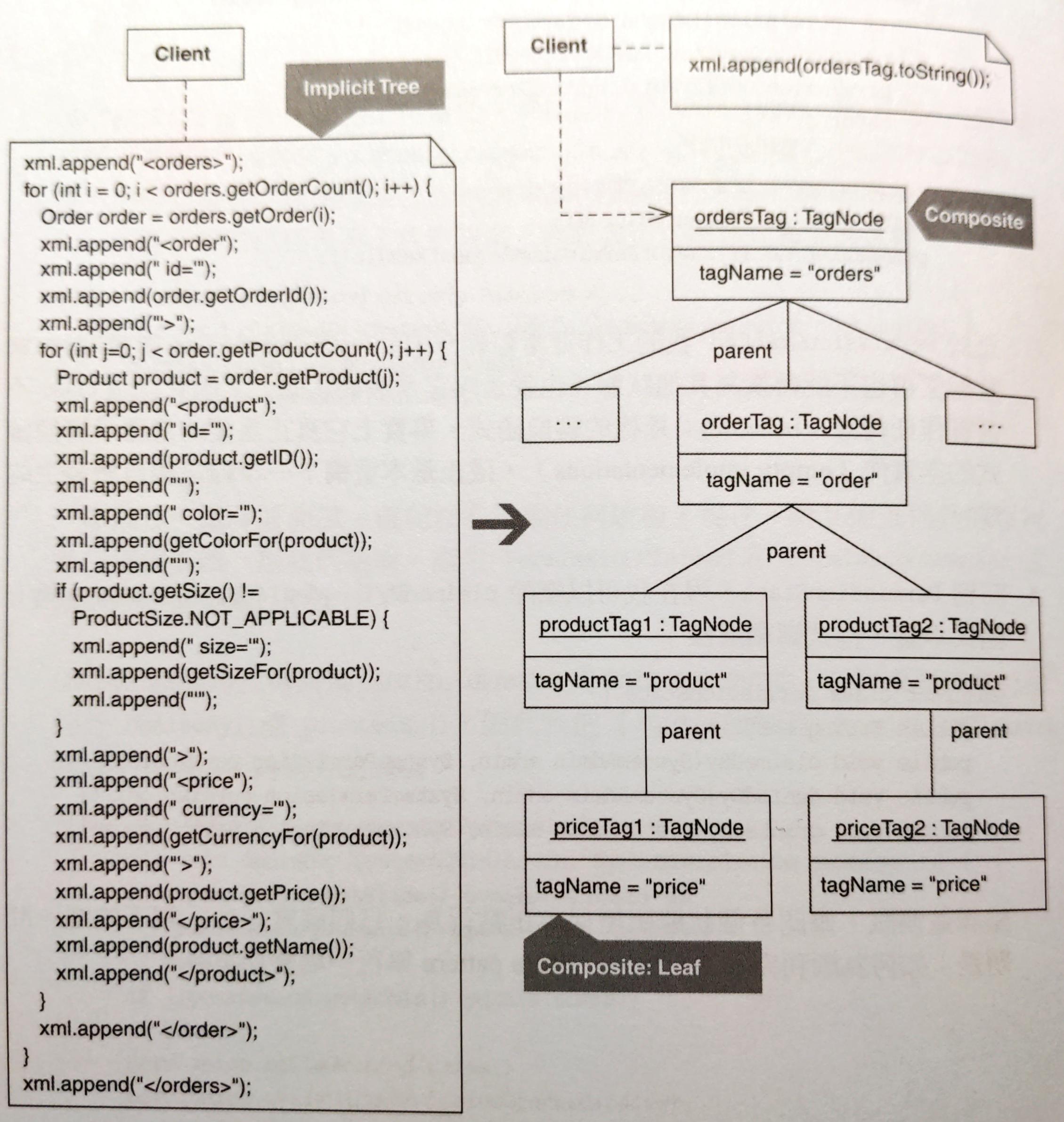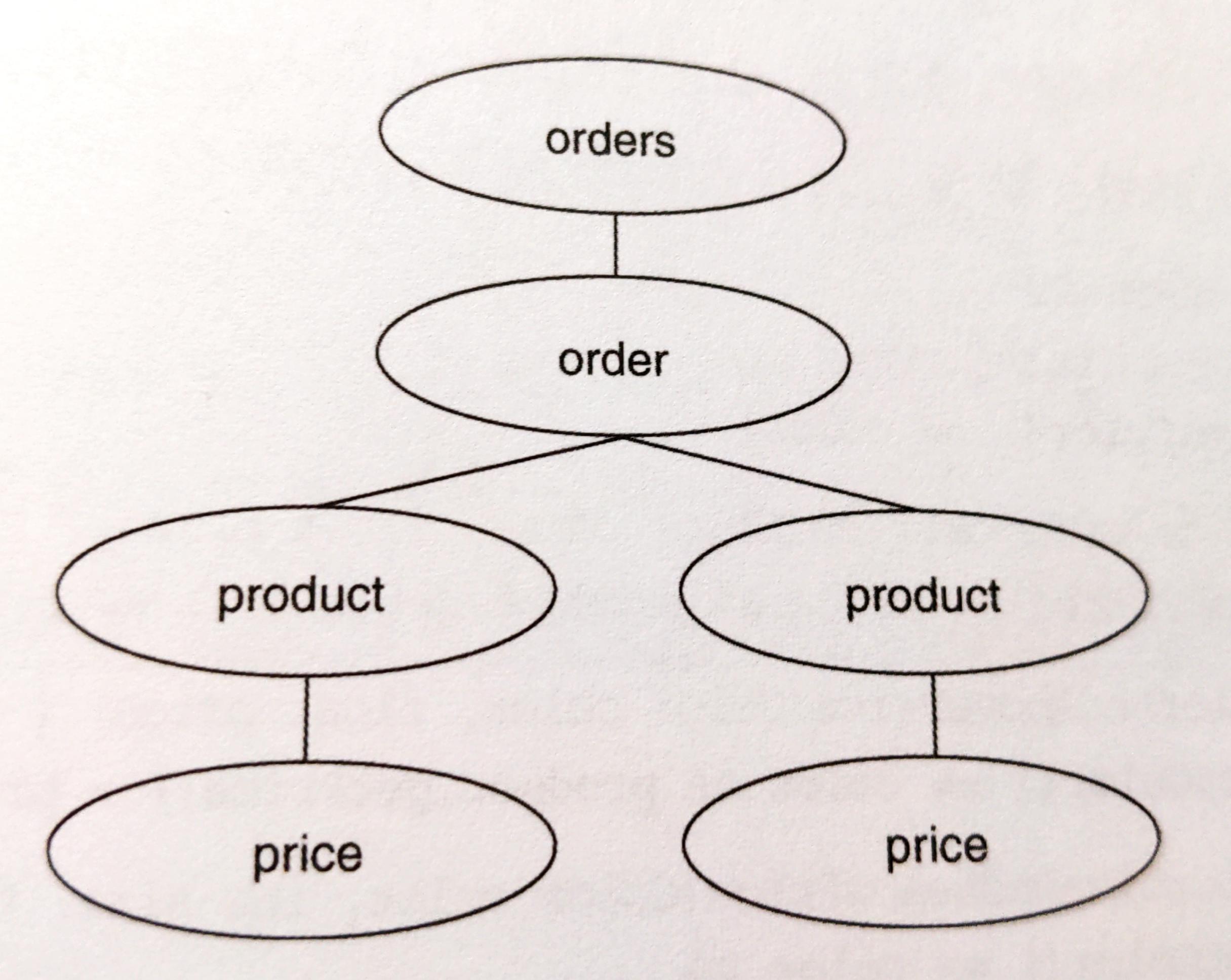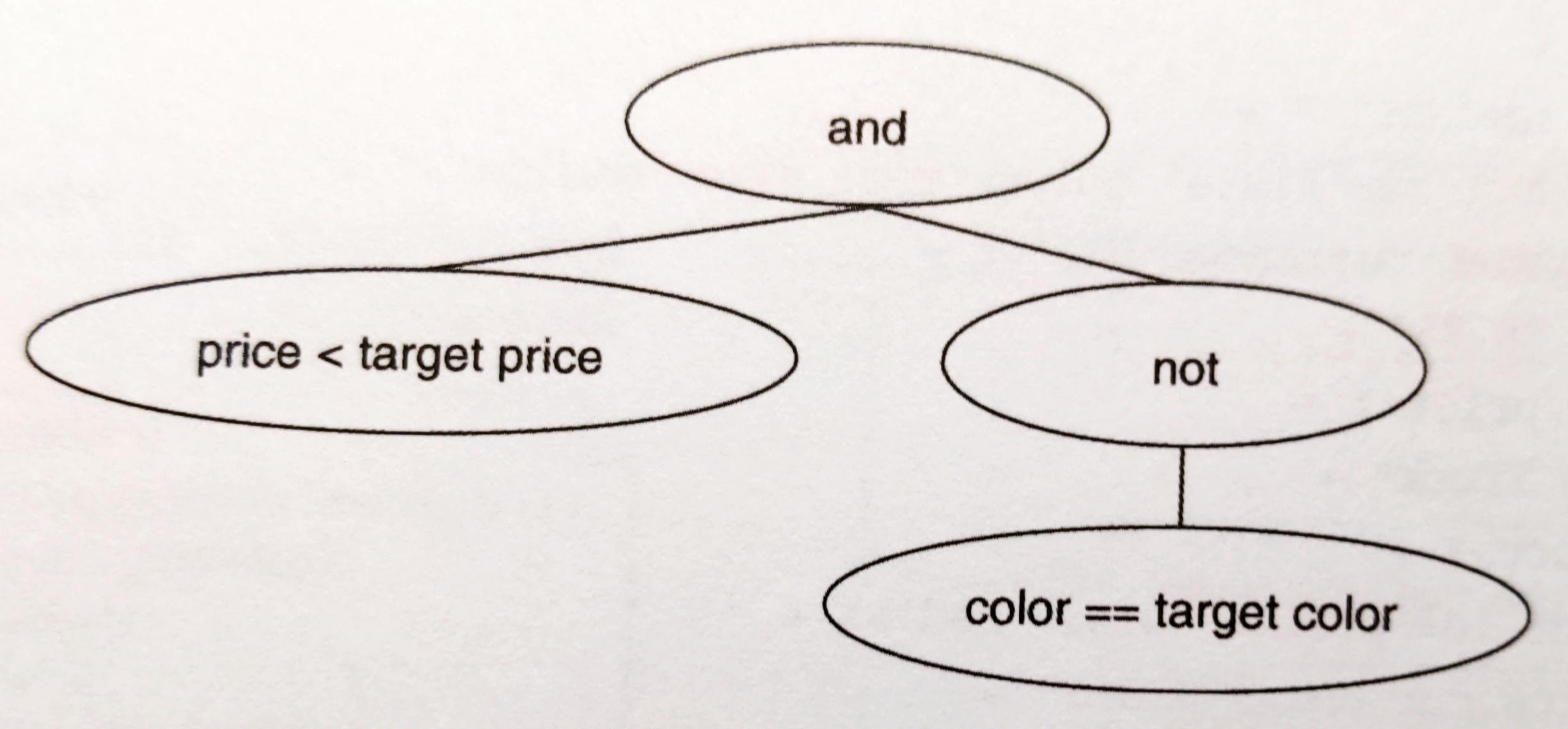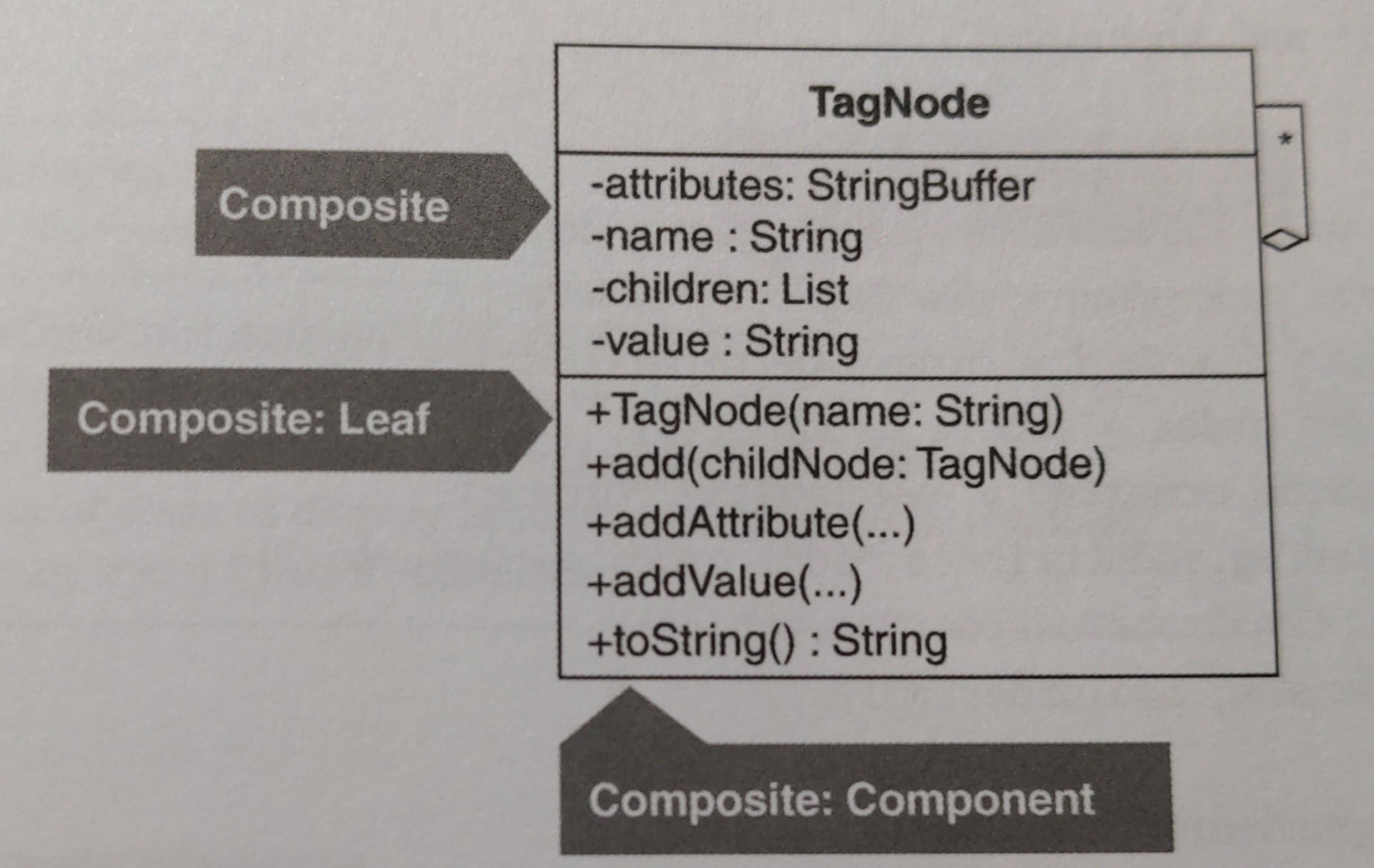# Replace Implicit Tree with Composite
以 Composite 取代隱寓的樹狀結構。
你不自覺塑造出一個樹狀結構,採用原始表述(primitive representation)e.g. String。
以 Composite 取代你的原始表述。

# 動機
資料或程式碼如果不是很明顯被建構成樹狀,但卻表現的像是樹狀,就是一種隱式樹狀結構。
String expectedResult =
"<orders>" +
"<order id=’321’>" +
"<product id=’f1234’ color=’red’ size=’medium’>" +
"<price currency=’USD’>" +
"8.95" +
"</price>" +
"Fire Truck" +
"</product>" +
"<product id=’p1112’ color=’red’>" +
"<price currency=’USD’>" +
"230.0" +
"</price>" +
"Toy Porsche Convertible" +
"</product>" +
"</order>" +
"</orders>"
2
3
4
5
6
7
8
9
10
11
12
13
14
15
16
17

條件邏輯也可以表達成樹,如下:
public class ProductFinder...
public List belowPriceAvoidingAColor(float price, Color color) {
List foundProducts = new ArrayList();
Iterator products = repository.iterator();
while (products.hasNext()) {
Product product = (Product) products.next();
if ( product.getPrice() < price && product.getColor() != color )
foundProducts.add(product);
}
return foundProducts;
}
2
3
4
5
6
7
8
9
10
11

優點
- 封裝反覆命令。例如:縮排、新增或移除節點。
- 提供一般化的方法來處理「相似邏輯擴散與激增」。
- 簡化客戶端的建構任務。
缺點
- 讓設計變得更複雜 -- 如果建構 implicit trees 比較簡單的話。
# 作法
兩種作法:
- 在 implicit tree 上面重構:refactor to Composite
- 利用測試驅動開發來達成 refactor to Composite
如果 implicit tree 不適合重構,就可以用測試驅動開發。
辨識出一個 implicit leaf,它是 implicit tree 的一部分,能用新的 class 來模塑。
利用 Extract Class 或是測試驅動開發來建立這個 class。如果 implicit leaf 擁有屬性,請在 leaf node 中產生這些屬性。
以 leaf node 的實體取代出現的每一個 implicit leaf,讓 implicit tree 依賴 leaf node 而非 implicit leaf。
為 implicit tree 中的其他任何 implicit leaf 重複步驟 1&2。
想辦法確保你建立的 leaf node 共享同一個 interface,可以實施 Extract Superclass 或 Extract Interface 來建立這個 interface。類似 1. 的作法,找出 implicit parent。
- 客戶端必須能夠經由建構式或是
add(...)在 parent node 中增加 leaf nodes。 - parent node 必須對所有 children (經由其 interface)一視同仁。
- parent node 不一定要實作共同 interface。
- 如果客戶端有能力將 parent nodes 加到 parent nodes 中,或是如果你希望客戶碼對 leaf node 和 parent node 不分彼此(參考 Replace One/Many Distinctions with Composite 動機),那就讓 parent node 也實作那個共同的 interface。
- 客戶端必須能夠經由建構式或是
以「使用 parent node 實體並配備正確的 leaf node 實體」的程式碼取代每個 implicit parent。
為其他 implicit parents 重複步驟 4&5。
# 範例
先使用 Composite Method 和 Move Accumulation to Collecting Parameter 把龐大的 getContents 切割成較小的函式:
public class OrdersWriter {
private Orders orders;
public OrdersWriter(Orders orders) {
this.orders = orders;
}
public String getContents() {
StringBuffer xml = new StringBuffer();
writeOrderTo(xml);
return xml.toString();
}
private void writeOrderTo(StringBuffer xml) {
xml.append("<orders>");
for (int i = 0; i < orders.getOrderCount(); i++) {
Order order = orders.getOrder(i);
xml.append("<order");
xml.append(" id=’");
xml.append(order.getOrderId());
xml.append("’>");
writeProductsTo(xml, order);
xml.append("</order>");
}
xml.append("</orders>");
}
private void writeProductsTo(StringBuffer xml, Order order) {
for (int j=0; j < order.getProductCount(); j++) {
Product product = order.getProduct(j);
xml.append("<product");
xml.append(" id=’");
xml.append(product.getID());
xml.append("’");
xml.append(" color=’");
xml.append(colorFor(product));
xml.append("’");
if (product.getSize() != ProductSize.NOT_APPLICABLE) {
xml.append(" size=’");
xml.append(sizeFor(product));
xml.append("’");
}
xml.append(">");
writePriceTo(xml, product);
xml.append(product.getName());
xml.append("</product>");
}
}
private void writePriceTo(StringBuffer xml, Product product) {
xml.append("<price");
xml.append(" currency=’");
xml.append(currencyFor(product));
xml.append("’>");
xml.append(product.getPrice());
xml.append("</price>");
}
2
3
4
5
6
7
8
9
10
11
12
13
14
15
16
17
18
19
20
21
22
23
24
25
26
27
28
29
30
31
32
33
34
35
36
37
38
39
40
41
42
43
44
45
46
47
48
49
50
51
52
53
為何要寫成 writeOrderTo writeProductsTo writePriceTo,而不直接從 domain objects 呼叫 toXML()?考慮以下範例:
<order id=’987’ totalPrice=’14.00’>
<product id=’f1234’ price=’9.00’ quantity=’1’> Fire Truck </product>
<product id=’f4321’ price=’5.00’ quantity=’1’> Rubber Ball </product>
</order>
<orderHistory>
<order date=’20041120’ totalPrice=’14.00’>
<product id=’f1234’>
<product id=’f4321’>
</order>
</orderHistory>
<order id=’321’>
<product id=’f1234’ color=’red’ size=’medium’>
<price currency=’USD’> 8.95 </price>
Fire Truck
</product>
</order>
2
3
4
5
6
7
8
9
10
11
12
13
14
15
16
17
18
在每個 domain object 上使用單一的 toXML() 是很困難且棘手的工作,因為每個 XML 情況都不一樣。可行解法:
- 在 domain objects 外部進行 XML 轉譯。
- 使用 Visitor (參考 Move Accumulation to Visitor)
接下來開始本章的重構:
找出 implicit leaf。
String expectedResult = "<orders>" + "<order id=’321’>" + "<product id=’f1234’ color=’red’ size=’medium’>" + "<price currency=’USD’>" + "8.95" + "</price>" + "Fire Truck" + "</product>" + "</order>" + "</orders>";1
2
3
4
5
6
7
8
9
10
11考慮要將
<price>...</price>tag 當作 leaf 還是8.95? 這裡選擇前者。 觀察每個 XML tag 會有:- name
- attribute
- children (optional)
- value (optional)
所以可以用一個通用的 leaf node 表達所有 implicit leaves。
接下來以測試驅動開發產生這個 class:
public class TagTests extends TestCase { private static final String SAMPLE_PRICE = "8.95"; public void testSimpleTagWithOneAt tributeAndValue() { TagNode priceTag = new TagNode("price"); priceTag.addAttribute("currency", "USD"); priceTag.addValue(SAMPLE_PRICE); String expected = "<price currency=" + "’" + "USD" + "’>" + SAMPLE_PRICE + "</price>"; assertEquals("price XML", expected, priceTag.toString()); } } public class TagNode { private String name = ""; private String value = ""; private StringBuffer attributes; public TagNode(String name) { this.name = name; attributes = new StringBuffer(""); } public void addAttribute(String attribute, String value) { attributes.append(" "); attributes.append(attribute); attributes.append("=`"); attributes.append(value); attributes.append("`" ); } public void addValue(String value) { this.value = value; } public String toString() { String result; result = "<" + name + attributes + ">" + value + "</" + name + ">"; return result; } }1
2
3
4
5
6
7
8
9
10
11
12
13
14
15
16
17
18
19
20
21
22
23
24
25
26
27
28
29
30
31
32
33
34
35現在用
TagNode取代getContents()中的 implicit leaf:public class OrdersWriter { private void writePriceTo(StringBuffer xml, Product product) { TagNode priceNode = new TagNode("price"); priceNode.addAttribute("currency", currencyFor(product)); priceNode.addValue(priceFor(product)); xml.append(priceNode.toString()); // xml.append("<price"); // xml.append(" currency=’"); // xml.append(currencyFor(product)); // xml.append("’>"); // xml.append(product.getPrice()); // xml.append("</price>"); } }1
2
3
4
5
6
7
8
9
10
11
12
13
14由於
TagNode模塑出 XML 的所有 implicit leaves,因此不需要重複步驟 1&2 進行轉換,也不需要確認所有新的 leaf nodes 是否共用相同 interface,因為它已經是了。現在要找出 implicit parent:
<product>,<price>,<order>, ... 由於這些每個都和 leaf 相似,可以藉由在TagNode中加入「支援 child-handling」來產生 parent node。以下利用測試驅動開發產生:public void testCompositeTagOneChild() { TagNode productTag = new TagNode("product"); productTag.add(new TagNode("price")); String expected = "<product>" + "<price>" + "</price>" + "</product>"; assertEquals("price XML", expected, productTag.toString()); } public class TagNode { private List children; public String toString() { String result; result = "<" + name + attributes + ">"; Iterator it = children().iterator(); while (it.hasNext()) { TagNode node = (TagNode)it.next(); result += node.toString(); } result += value; result += "</" + name + ">"; return result; } private List children() { if (children == null) children = new ArrayList(); return children; } public void add(TagNode child) { children().add(child); } } public void testAddingChildrenAndGrandchildren() { String expected = "<orders>" + "<order>" + "<product>" + "</product>" + "</order>" + "</orders>"; TagNode ordersTag = new TagNode("orders"); TagNode orderTag = new TagNode("order"); TagNode productTag = new TagNode("product"); ordersTag.add(orderTag); orderTag.add(productTag); assertEquals("price XML", expected, ordersTag.toString()); }1
2
3
4
5
6
7
8
9
10
11
12
13
14
15
16
17
18
19
20
21
22
23
24
25
26
27
28
29
30
31
32
33
34
35
36
37
38
39
40
41
42
現在,以「使用 parent node 實體並配置正確的 leaf node 實體」的程式碼取代出現的每個 implicit parent。例如:
public class OrdersWriter { private void writeProductsTo(StringBuffer xml, Order order) { for (int j=0; j < order.getProductCount(); j++) { Product product = order.getProduct(j); TagNode productTag = new TagNode("product"); productTag.addAttribute("id", product.getID()); productTag.addAttribute("color", colorFor(product)); if (product.getSize() != ProductSize.NOT_APPLICABLE) productTag.addAttribute("size", sizeFor(product)); writePriceTo(productTag, product); productTag.addValue(product.getName()); xml.append( productTag.toString() ); } } private void writePriceTo(TagNode productTag, Product product) { TagNode priceTag = new TagNode("price"); priceTag.addAttribute("currency", currencyFor(product)); priceTag.addValue(priceFor(product)); productTag.add(priceTag); } }1
2
3
4
5
6
7
8
9
10
11
12
13
14
15
16
17
18
19
20
21
22
23重複 4&5。
public class OrdersWriter { public String getContents() { StringBuffer xml = new StringBuffer(); writeOrderTo(xml); return xml.toString(); } private void writeOrderTo(StringBuffer xml) { TagNode ordersTag = new TagNode("orders"); for (int i = 0; i < orders.getOrderCount(); i++) { Order order = orders.getOrder(i); TagNode orderTag = new TagNode("order"); orderTag.addAttribute("id", order.getOrderId()); writeProductsTo(orderTag, order); ordersTag.add(orderTag); } xml.append(ordersTag.toString()); } private void writeProductsTo(TagNode orderTag, Order order) { for (int j=0; j < order.getProductCount(); j++) { Product product = order.getProduct(j); TagNode productTag = new TagNode("product"); productTag.addAttribute("id", product.getID()); productTag.addAttribute("color", colorFor(product)); if (product.getSize() != ProductSize.NOT_APPLICABLE) productTag.addAttribute("size", sizeFor(product)); writePriceTo(productTag, product); productTag.addValue(product.getName()); orderTag.add(productTag); } } private void writePriceTo(TagNode productTag, Product product) { TagNode priceNode = new TagNode("price"); priceNode.addAttribute("currency", currencyFor(product)); priceNode.addValue(priceFor(product)); productTag.add(priceNode); } }1
2
3
4
5
6
7
8
9
10
11
12
13
14
15
16
17
18
19
20
21
22
23
24
25
26
27
28
29
30
31
32
33
34
35
36
37
38